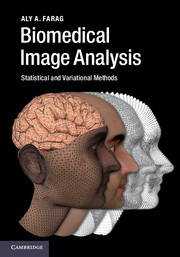Book contents
- Frontmatter
- Dedication
- Contents
- Preface
- Nomenclature
- 1 Overview of biomedical image analysis
- Part I Signals and systems, image formation, and image modality
- Part II Stochastic models
- Part III Computational geometry
- Part IV Variational approaches and level sets
- Part V Image analysis tools
- 11 Segmentation: statistical approach
- 12 Segmentation: variational approach
- 13 Basics of registration
- 14 Variational methods for shape registration
- 15 Statistical models of shape and appearance
- Index
- References
15 - Statistical models of shape and appearance
from Part V - Image analysis tools
Published online by Cambridge University Press: 05 November 2014
- Frontmatter
- Dedication
- Contents
- Preface
- Nomenclature
- 1 Overview of biomedical image analysis
- Part I Signals and systems, image formation, and image modality
- Part II Stochastic models
- Part III Computational geometry
- Part IV Variational approaches and level sets
- Part V Image analysis tools
- 11 Segmentation: statistical approach
- 12 Segmentation: variational approach
- 13 Basics of registration
- 14 Variational methods for shape registration
- 15 Statistical models of shape and appearance
- Index
- References
Summary
Introduction
In this chapter, statistical models, derived from the shape and texture of an object in an image or volume, are studied. Statistical shape and appearance models can capture patterns of variability in shape and gray-level appearance. They form the basis of two of the most powerful tools for object analysis – active shape models (ASM) and active appearance models (AAM) – and are very popular in the computer vision and biomedical imaging analysis literature. This chapter reviews the basic foundation of these two statistical models and provides illustrative examples of their effectiveness in object modeling. The chapter builds upon various ideas studied in previous chapters.
Statistical shape models
The shape of an object can be represented by a set of n points, which can be in any dimension (i.e., 2D or 3D). Adopting Kendall’s definition [15.1][15.2], shape is formally defined as:
DEFINITION 15.1 A shape embodies all the geometrical information that remains when location, scale, and rotational effects are filtered out from an object. ■
Information
- Type
- Chapter
- Information
- Biomedical Image AnalysisStatistical and Variational Methods, pp. 417 - 457Publisher: Cambridge University PressPrint publication year: 2014
